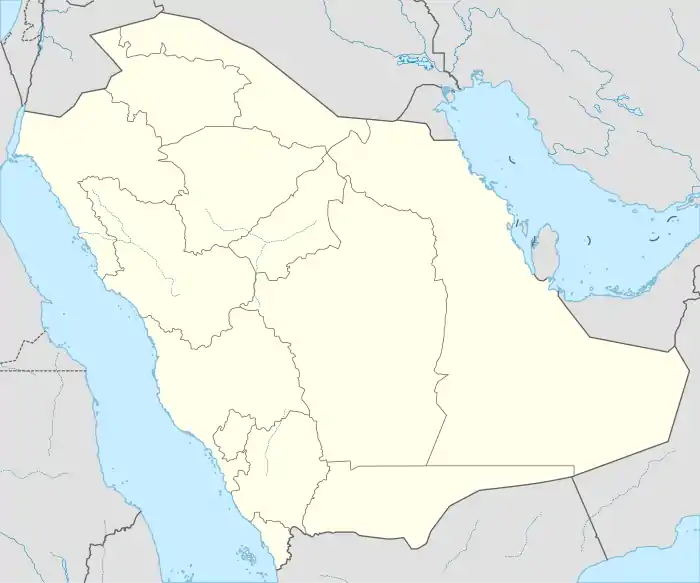Land of Tema
The Land of Tema, Te'-ma or Tema (Hebrew: תֵּמָא, Greek: Θαιμάν, Arabic: تيماء and Thaiman) is a place mentioned in the Bible[1][2] where the descendants of Ishmael's son Tema dwelt. In Hebrew, the name means "south country". It was most likely in northern Saudi Arabia and has been identified with the modern Teima',[3][1][2][4] an oasis (fitting with the description in Jeremiah) which lies about 200 miles (320 km) north of Medina, and some 40 miles (64 km) south of Dumat (Dumah), now known as el-Jauf. Teima' is on the ancient caravan road connecting the Persian Gulf with the Gulf of Aqaba which in antiquity bought wealth to the town.[5][6] Doughty has described at Teima the ruins of an old city wall 3 miles (4.8 km) in circuit.[7] An Aramaic stele recently discovered, belonging to the 6th century BC, shows the influence of Assyrian in the town. The place is mentioned in the cuneiform inscriptions.[8][9] The possibility of its being on a trade route is supported by the reference in Job 6:19.[10] It is often associated with the Land of Dumah.
Tayma | |
|---|---|
.jpg.webp) Landscape near Tema | |
 Tayma Location in Saudi Arabia | |
| Coordinates: 27°37′47″N 38°32′38″E |
The Bible mentions Tema several times, including Isaiah 21:14; Jeremiah 25:23, 49:7, 49:20; Obadiah 1:9; and Amos 1:12. One of the protagonists in Job is Eliphaz the Temanite, and 1 Chronicles refers to Husham of the land of the Temanites.
Outside of the Bible, it was mentioned by Ptolemy,[11] Pliny,[12] Agatharchides,[13][14] and Josephus.[15] It was noted as halfway between Damascus and Mecca, and between Babylonia and Egypt.[16] Yaqut mentions that in the Middle Ages, it was inhabited by a Jewish Community.[17] Nabunaid of Babylon captured the city [18][3] and settled there until Cyrus the Great captured the city and moved him to Carmania.
References
- S. Smith, Babylonian Historical Texts (1924), 98-123
- Arnulf Hausleitner, "Tayma - eine frühe Oasensiedlung", in: Archäologie in Deutschland, 3/213, pp. 14–19
- R. P. Dougherty, Nabonidus and Belshazzar. (1929) p 1-5-200
- Rev Charles Foster, The historical geography of Arabia; or, The patriarchal evidences of revealed religion. With an appendix containing translations of the Hamyaritic inscriptions recently discovered in Hadramaut, Volume 1 (1844) p 294.
- See Job 6:19
- See:Isaiah 21:14
- R. P. Dougherty, Arabia Deserta, I, p285
- Schrader, KAT2, 149
- Tema at BibleAtlas.com.
- Alter, Robert (2019). The Hebrew Bible: The Writings. Norton.
- Ptolemy 5:19, section 6
- Pliny, Geogr. 5, 19 and Hist. Nat. 6:32
- Rev Charles Foster, The historical geography of Arabia; or, The patriarchal evidences of revealed religion. With an appendix containing translations of the Hamyaritic inscriptions recently discovered in Hadramaut, Volume 1 (Duncan and Malcom, 1844) p294.
- Agatharchides LXX
- Josephus Antiquities X.xi.2
- Rodolfo C. Estimo Jr. (7 November 2010). "Pharaonic inscription found in Saudi Arabia". ArabNews.
- Yaqut, Šihāb al-Dīn ibn ‘Abd Allah al-Ḥamawī. "Mu’jam al-Buldān". Dār Ṣādir, Beirut 1995, p. 67
- Jack Finegan, Light from the Ancient Past, Vol. 1: The Archaeological Background of the Hebrew-Christian Religion (Princeton University Press, 8 Dec. 2015) p190.